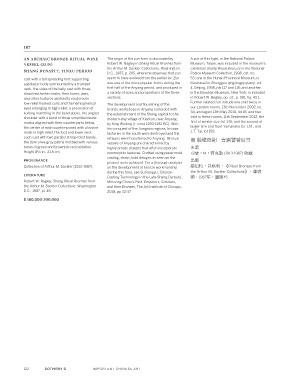Page 124 - Sotheby's Chinese Art and Porcelain Auction New York September 12, 2018
P. 124
187
AN ARCHAIC BRONZE RITUAL WINE The origin of the zun form is discussed by A zun of this type, in the National Palace
VESSEL (ZUN) Robert W. Bagley in Shang Ritual Bronzes from Museum, Taipei, was included in the museum’s
the Arthur M. Sackler Collections, Washington exhibition Shang Ritual Bronzes in the National
SHANG DYNASTY, YINXU PERIOD
D.C., 1987, p. 265, where he observes that zun Palace Museum Collection, 1998, cat. no.
cast with a tall spreading foot supporting seem to have evolved from the earlier lei. Zun 53; one in the Hunan Provincial Museum, is
a globular body surmounted by a trumpet was one of the more popular forms during the illustrated in Zhongguo qingtongqi quanji, vol.
neck, the sides of the belly cast with three Þ rst half of the Anyang period, and produced in 4, Beijing, 1998, pls 117 and 118; and another,
dissolved taotie masks, their horns, jaws, a variety of sizes and proportions of the three in the Brooklyn Museum, New York, is included
and other features abstractly rendered in sections. in Robert W. Bagley, op. cit., p. 281, Þ g. 45.1.
low-relief hooked curls and the hemispherical The development and ß ourishing of the Further related zun include one sold twice in
eyes emerging in high relief, a procession of bronze workshops in Anyang coincided with our London rooms, 13th November 2002, lot
kuilong marching in the band above, the angled the establishment of the Shang capital to the 34, and again 12th May 2010, lot 16; and two
shoulder with a band of three simpliÞ ed taotie modern-day village of Xiaotun, near Anyang, sold in these rooms, 11th September 2012, the
masks aligned with their counterparts below, by King Wuding (r. circa 1250-1192 BC). With Þ rst of similar size, lot 146, and the second of
the center of each superimposed with a bovine his conquest of the Jiangnan regions, bronze larger size and from Yamanaka Co. Ltd., and
mask in high relief, the foot and lower neck factories in the south were destroyed and the J.T. Tai, lot 159.
each cast with two parallel string-relief bands, artisans were transferred to Anyang. Bronze
the dark olive-gray patina mottled with various vessels of Anyang are characterized by ⓮ġ㭟⡇㗪㛇ġġġ曺戭棽棖䲳⮲
tones of green and brownish-red oxidation highly ornate designs that often incorporate Ը๕
Height 8½ in., 21.6 cm zoomorphic features. Crafted using piece-mold Ṇ䐇ɀMɀ岥≺ġĩ1913Į1987Īġ㓞啷
casting, sharp, bold designs as seen on the
PROVENANCE ̈و
present were achieved. For a thorough analysis
Collection of Arthur M. Sackler (1913-1987). on the development of bronze workmanship 伭ỗ䈡ɀ居㟤⇑炻˪RitualġBronzesġfromġ
during this time, see Su Rongyu, ‘Bronze- theġArthurġMįġSacklerġCollections˫炻厗䚃
LITERATURE
Casting Technology in the Late Shang Dynasty’, 枻炻1987⸜炻⚾䇰45
Robert W. Bagley, Shang Ritual Bronzes from Mirroring China’s Past. Emperors, Scholars,
the Arthur M. Sackler Collections, Washington and their Bronzes, The Art Institute of Chicago,
D.C., 1987, pl. 45. 2018, pp 32-37.
$ 180,000-200,000
122 SOTHEBY’S IMPORTANT CHINESE ART

